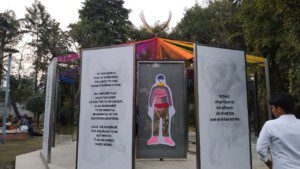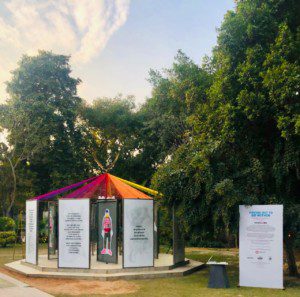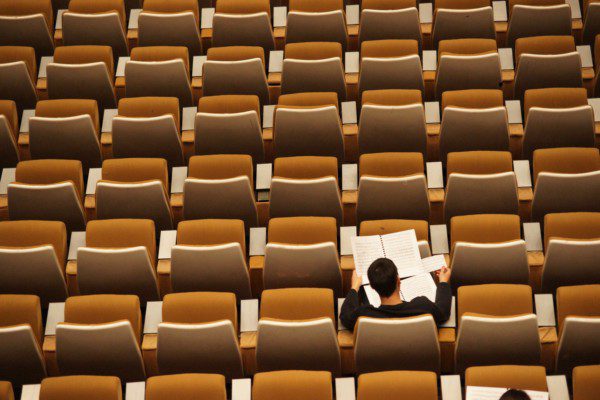As American college students report escalating rates of anxiety and depression, they may be comforted to know that students around the world share similar struggles. A 2018 report by the World Health Organization’s World Mental Health International College Student Initiative revealed that one in three first-year students from eight countries reported symptoms consistent with a diagnosable mental health disorder. Three years and a global pandemic later, the situation is assumed worse, and even countries resistant to discussing mental health are opening up about the growing crisis, India being among them.
“The levels of awareness of mental health issues among both student bodies are much sharper now than in the past, which comes with both threats and possibilities. This is particularly unusual for India, where it was never an issue in the public domain,” he said. “That goes along with the fact that students are facing unprecedented levels of anxiety and academic pressure.”Bhrigupati “Bhrigu” Singh is a first-hand witness to these shifting attitudes in India, where suicide has become a major public health concern. He designed and taught a popular course titled “The Anthropology of Mental Health” at Brown University in 2018, and is now teaching this course to students at Ashoka University in India. Bhrigu says that while perceptions and delivery of mental health care vary significantly between the two countries, students themselves are becoming more similar in the way they characterize their distress. He also believes the two student bodies are coming closer together in their willingness to discuss their experiences.
Bhrigu acknowledges that while mental health survey data is less available in India, there is a widespread sense of a crisis that needs to be addressed. “While it is often said that such issues are not openly discussed in India, I was quite surprised by how aware students at Ashoka and other universities are of diagnostic vocabularies, in ways that is a discursive shift from even ten years ago,” he said.

While the urgency of the problem may be felt throughout the university system, how it is addressed varies by institution, with public universities – long recognized as the backbone of the Indian university system – often lacking robust mental health resources. As a private, “elite” institution, Ashoka holds a unique advantage in this regard, with access to the Ashoka Centre for Wellbeing which offers free, non-judgmental and confidential counseling and psychological support for students, staff, and faculty. Now in its sixth year, the Centre is headed by its founding executive director, Dr. Arvinder Singh.
“The uniqueness of the centre lies in its approach,” she said. “By combining the preventative, promotive, and curative aspects of mental health, it aspires to open conversations and build student collaboration. Values like inclusivity shine through. We engage with all stakeholders (students, parents, faculty, and staff) that encourage a holistic narrative of wellbeing.”
Both Arvinder and Bhrigu are particularly grateful for the ability to develop mental health initiatives at Ashoka as their community, and others across the country, reel from the grief and loss that India has experienced, particularly due to the severity of the “second wave” of the pandemic in 2021. They anticipate the Centre’s capacity for mental health support will be further tested this year, as will the degree to which it has succeeded in opening up the conversation on mental health and wellbeing.
Pioneering Practices
The original goal of the Ashoka Centre for Wellbeing was to bridge the emotional gap students were experiencing when leaving home and living independently from their parents – something many American students might experience, but with a few exceptions related to culture.
“In India, high school is very structured and focused more on the binary of right and wrong,” said Arvinder. “A place like Ashoka challenges their thinking and offers an opportunity to question beyond the given binary or status quo. This can be overwhelming for students.”
Arvinder noted that Indian families have a particular power dynamic that might be unfamiliar to American households. For example, parents, and sometimes grandparents, may influence major decisions in a young person’s life. With this in mind, in its second year, the Centre created an additional program to manage the transition of the family along with the student, orienting the parents to the emotional and psychological wellbeing of the student while creating space for conversations about handling stress and anxiety without stigma.
Talking about these kinds of issues may seem commonplace on U.S. campuses, with student mental health now at the top of most presidents’ priority lists. But in India, cultural, class, and institutional resource dynamics strongly affect how open communities are in acknowledging mental health; and in embracing methods of addressing problems.
“There is a lot that is misinterpreted abut mental health globally,” Arvinder said. “In India, it might be represented through the dismissal of talking about depression, for example, within the family, and being asked to be strong, or exercise willpower to feel less sad. There might be a belief that yoga, meditation, or reiki might fix the problem, and of course that’s not always the case.”

Both Arvinder and Bhrigu acknowledge a strong resistance in India to psycho-pharmaceutical medicalization, something their community perceives as an American phenomenon drawing from an overly-diagnostic culture. “Our model is more holistic – more within the wellbeing space and less reliant solely on medicine because that makes people hesitant,” Arvinder said.
Bhrigu adds, “Pharma culture in India is itself a tremendously interesting field of study. India is widely known as the world’s highest consumer of antibiotics, while psychic distress is approached in much more varied ways, not only because of “stigma,” but also because the idea of the psyche is often imagined in ontologically diverse ways, for example through religious healing.” Bhrigu adds that, in his class, he tries to teach students to better understand the threats and possibilities of these diverse ontologies, rather than simply taking up a polemic against “medicalization” or, alternately, thinking that religious healing is merely “superstition.”
Arvinder said the Centre’s approach to mental health is through a wellbeing lens, as opposed to a diagnostic lens, and she views mental health issues as being on a spectrum that can go from “stress to distress to crisis” which follows a linear approach and offers an opportunity for prevention strategies. The Centre relies heavily on workshops, group therapy sessions, first responder training and student-led initiatives, all focused on normalizing the conversation.
“The difference in our approach is we strive to bring about a conversation about well-being and mental health across all stakeholders, with everyone contributing to the narrative,” she said. “This makes our student initiatives imperative to our collective success.”
The centre embraces mental health promotion with campaigns like “Self-Care is Not Selfish” and “Coffee and More,” where small groups informally discuss topics around anxiety and stress. For reasons both practical and efficacious, the Centre has created a strong para-professional network. “We believe that anyone can learn the skillset and operate with a compassionate heart to be a good listener and offer support,” Arvinder said.
She is also clear that the first responders do not replace, or attempt to replace, professional care. They aim to support and connect the student to the right resource. The Centre’s first responder training program for mental health accomplishes this through its ambassadors, teaching assistants, residential advisors, student government body, and referral services.
Into an Uncertain Future
The Ashoka Centre’s message is slowly becoming part of the university ecosystem, embraced by leadership, faculty, and students alike. But as Bhrigu says, “One of the questions is: What is the gap between what one says ought to be the case – the promise – and how this actually turns out in practice?” The same can be asked at U.S. universities, where under-staffed counseling centers struggle to meet the increasing demand for services while leadership espouses the importance of wellbeing.
In India, cultural, class, and institutional resource dynamics strongly affect how open communities are in acknowledging mental health; and in embracing methods of addressing problems.
As a social scientist, Bhrigu sees the Ashoka Centre’s use of paraprofessionals in addressing mental health as a harbinger of a directional change in the country based on two dynamics: the dearth of clinical professionals and the staggering emotional toll of COVID-19.

“As practitioners from the field of global mental health emphasize, there are only 3,600 or so psychiatrists in a population of 1.2 billion in India. So a lot of our future will unfold around this “task-shifting” or paraprofessional work, even as there are ongoing, heated debates on what this will look like in actual practice given the abysmally low government budgetary expenditure on health, and continuing debates on the dangers of “mass-producing” a medical model of mental illness,” he said.
In discussing the pandemic, both Bhrigu and Arvinder speak soberly of the uncertainty and fear the country continues to collectively feel, the grief and loss they are only beginning to process, and the distance they experience from the rest of the world.
“In 2020, India was analogous to most countries with lockdowns and travel restrictions,” said Bhrigu. “2021 was not a shared experience for us in terms of mortality and disease. The accounting of the emotional toll of so many deaths and so much loss is still unfathomable. In India, as in many parts of the world, trauma is often addressed by simply suppressing it, but it will spill out in other ways.”
Arvinder understands this all too well as witness to the emotional distress so many in her community are facing, from sadness and grief at the loss of family members to the disruption of the rituals meant to comfort them.
“To comprehend this grief, people are calling on clinical terms like depression,” she said. “However, this might be missing the element of collective grief caused by the physical, emotional and social disruptions of the pandemic.”
Bhrigu believes that the mental health crisis brought on by the pandemic might serve to change university culture in India, depending on the institution, with a widening of the gap between differently resourced institutions. “That said,” Bhrigu adds, “a peculiarity that anthropological work on mental
health brings to light is that it is not the case that elites, even those with access to medical care, necessarily do better than non-elites in terms of outcomes. Often the difference can be more fine-grained, in terms of forms of care and relatedness, which can also be a source of healing. Often care labors happen informally, in universities and homes, in ways that are unquantifiable.”
As the Ashoka Centre for Wellbeing attempts to heal its own community, it is also working with other universities to establish similar structures of support. They are planning a national conference in 2022 to create a space to share best practices for university mental health centers and encourage conversations about mental health and varying concepts of therapy at a national level.




